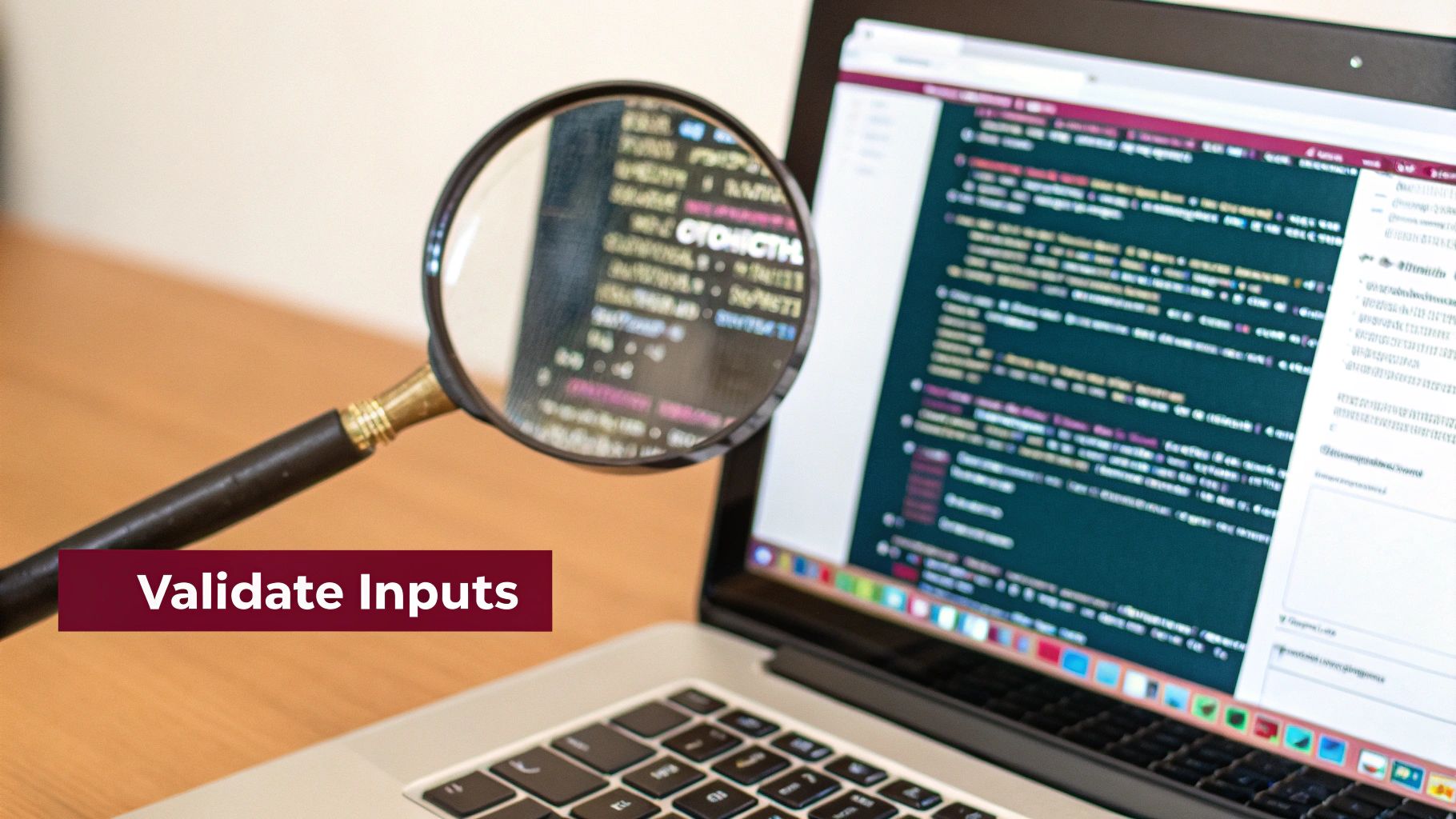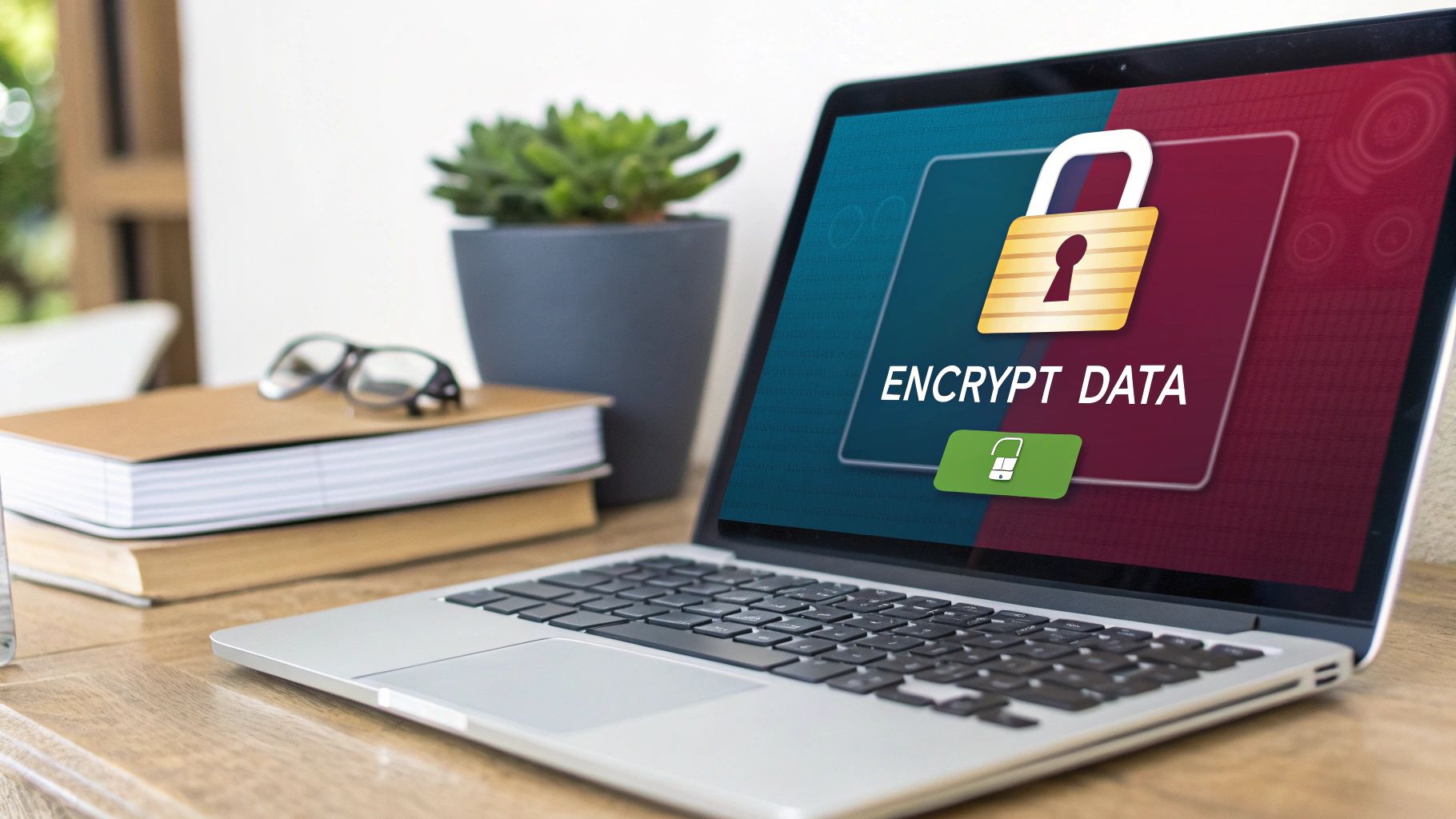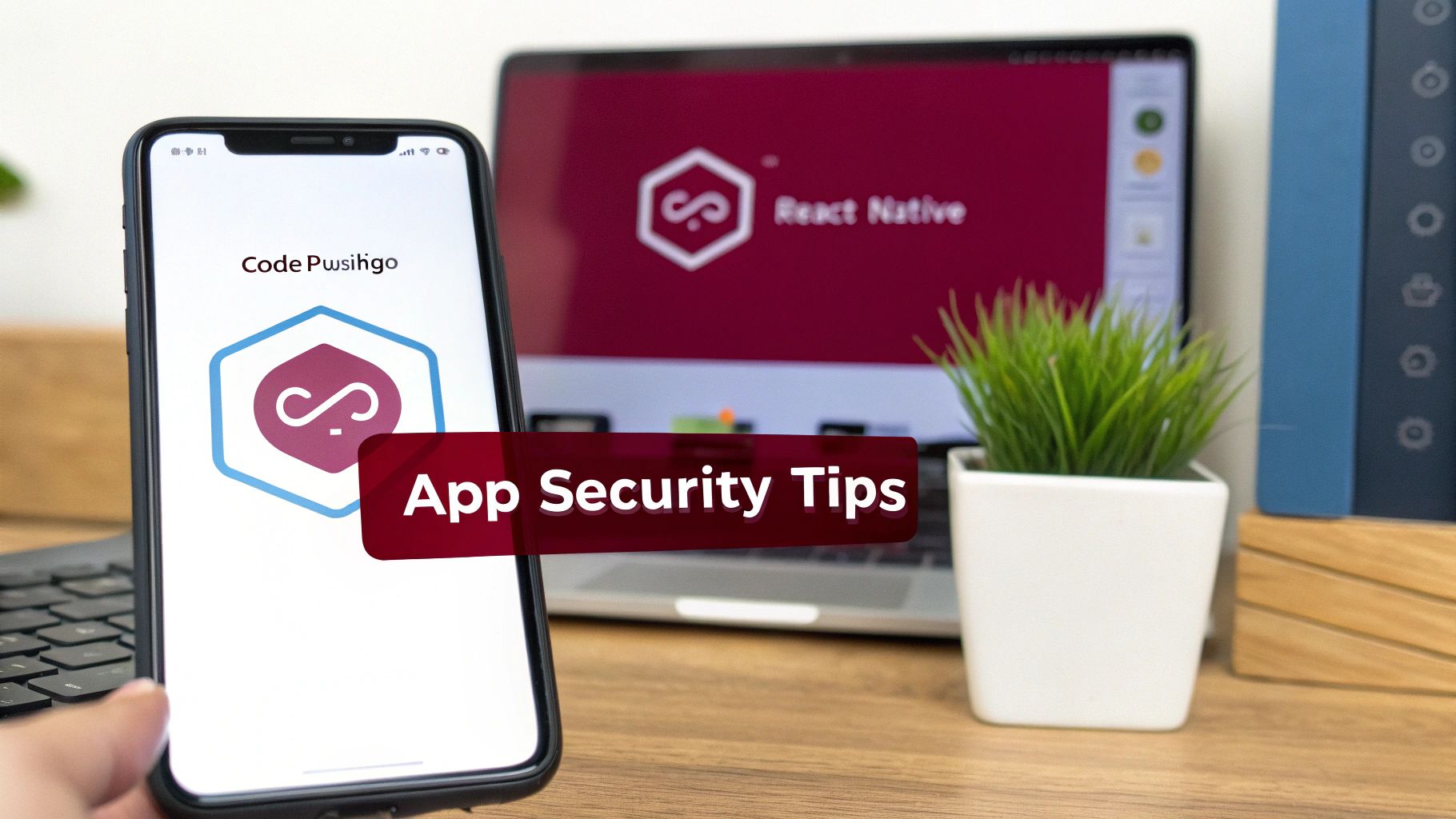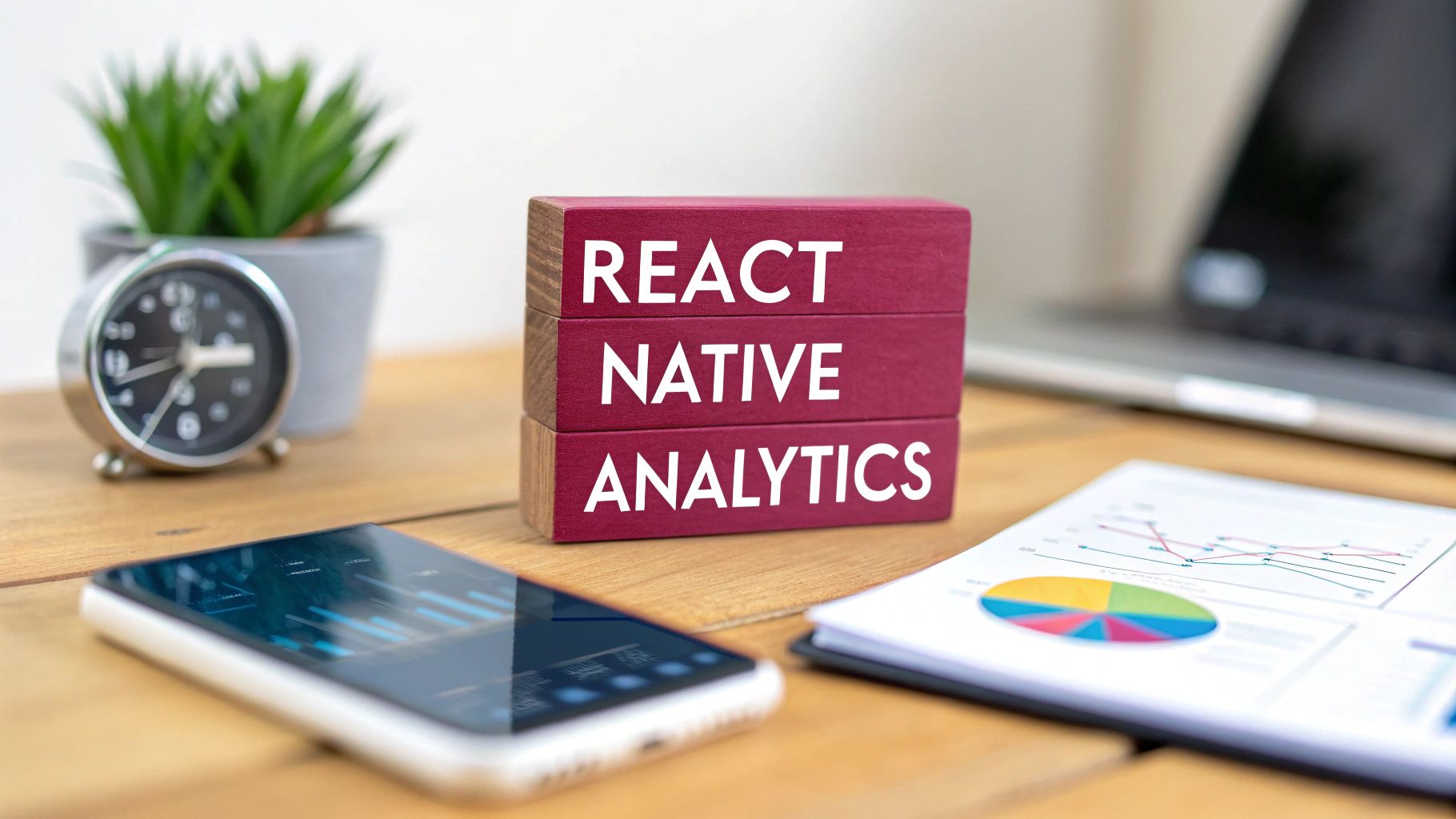In an era of rapid deployment and continuous updates, application security is no longer a final-stage checkpoint; it’s the foundation of trustworthy software. The rise of Over-The-Air (OTA) updates for mobile apps, particularly within the React Native ecosystem, introduces unique security challenges. While tools like CodePushGo empower developers to ship fixes and features instantly, this speed must be balanced with robust security protocols. Failing to secure the update pipeline can expose your application, your data, and your users to significant risks, transforming a powerful deployment tool into a potential attack vector.
This guide dives deep into 10 critical application security best practices, tailored for developers, DevOps engineers, and product managers navigating the complexities of modern, agile workflows. We will move beyond generic advice and focus on actionable strategies that can be directly implemented within your development lifecycle. From initial design to post-deployment monitoring, you’ll learn how to secure every part of the process, ensuring your OTA updates are not just fast, but fundamentally secure.
We’ll cover how to implement a “Secure by Design” philosophy, master input validation, and manage dependencies to prevent supply chain attacks. You’ll gain practical insights into secure data handling, API security, and integrating these practices into a DevSecOps culture. While our focus is on the specific challenges of mobile OTA updates, many foundational principles overlap with general web defense. For a broader understanding of general web application defense strategies, consider these 8 Website Security Best practices for 2025. This listicle will provide the targeted, in-depth knowledge needed to protect your React Native applications effectively.
1. Secure by Design (Shift-Left Security)
Integrating security from the very beginning of the software development lifecycle (SDLC) is the core principle of Secure by Design, also known as Shift-Left Security. Instead of treating security as a final-stage checkpoint, this approach embeds security requirements directly into the architecture and design phases. This proactive stance is one of the most effective application security best practices because it prevents vulnerabilities from being built into the system, making applications inherently more resilient.

Fixing a security flaw in production is exponentially more expensive and damaging than addressing it during design. By shifting left, you reduce remediation costs, minimize delays, and build a stronger security culture within your team. This methodology is particularly crucial in fast-paced environments like React Native development, where OTA updates can be frequent. Integrating security early aligns perfectly with agile methodologies, ensuring that speed does not come at the cost of safety. For more information, you can explore the principles of agile mobile app development.
Why It’s a Top Practice
Adopting a Secure by Design approach fundamentally changes how your team views security. It moves from a reactive, compliance-driven task to a proactive, quality-focused discipline. This prevents entire classes of vulnerabilities and reduces the attack surface of your application before a single line of code is written.
Actionable Implementation Tips
- Conduct Threat Modeling: Run threat modeling workshops during the initial design phase to identify potential threats, vulnerabilities, and required mitigations.
- Create Security User Stories: Write security requirements alongside functional user stories. For example, “As a user, I want my session to time out after 15 minutes of inactivity to prevent unauthorized access.”
- Establish Security Champions: Designate and train developers on each team to be security advocates, providing guidance and reviewing code from a security perspective.
- Use Established Frameworks: Leverage frameworks like the NIST Secure Software Development Framework (SSDF) or Microsoft’s Security Development Lifecycle (SDL) to structure your efforts.
2. Input Validation and Sanitization
Never trusting user-supplied data is a foundational principle of secure coding. Input validation and sanitization involve rigorously checking all incoming data against a strict set of rules and cleaning it of any potentially malicious characters or code. This is one of the most critical application security best practices because it serves as the first line of defense against a wide array of attacks, including Cross-Site Scripting (XSS), SQL injection, and command injection.

Effective validation confirms that data is in the expected format (syntactic validation) and makes sense within the application’s context (semantic validation). Sanitization then neutralizes any remaining dangerous elements. For instance, Stripe’s payment forms use robust validation to prevent injection attacks and ensure data integrity, while platforms like WordPress rely on sanitization functions (e.g., wp_sanitize_*) to secure user-generated content. This multi-layered defense is essential for protecting both your application and your users’ data.
Why It’s a Top Practice
Failing to validate and sanitize input leaves your application wide open to injection-based vulnerabilities, which consistently rank among the most common and severe security flaws according to the OWASP Top 10. By implementing this practice, you effectively block malicious actors from manipulating your application’s logic or accessing its underlying database, thereby preserving data integrity and preventing unauthorized actions.
Actionable Implementation Tips
- Validate on All Tiers: Implement validation on the client-side for better user experience and on the server-side for robust security. Never trust client-side validation alone.
- Use Parameterized Queries: To prevent SQL injection, always use parameterized queries or prepared statements instead of concatenating user input directly into SQL commands.
- Create Centralized Validation Libraries: Develop a shared, reusable library for validation routines to ensure consistency across the entire application and avoid duplicate code.
- Implement a Default-Deny Policy: Adopt an allow-list approach, where you explicitly define what is acceptable input and reject everything else. This is far more secure than trying to block known bad inputs (a block-list approach).
- Log and Monitor Failures: Keep detailed logs of validation failures. This data is invaluable for identifying and analyzing potential attack patterns or discovering bugs in your validation logic.
3. Authentication and Authorization Controls
Implementing robust mechanisms to verify who a user is (authentication) and what they are allowed to do (authorization) is a cornerstone of digital security. These controls serve as the primary gatekeepers for your application, ensuring that only legitimate users can access sensitive data and perform actions appropriate to their roles. This dual-layered approach is one of the most critical application security best practices because it directly prevents unauthorized access, data breaches, and misuse of application features.

Authentication confirms a user’s identity, often through credentials like passwords, biometrics, or security tokens. Authorization then determines the specific resources and functionalities that authenticated user can access. In a React Native application that uses OTA updates, for instance, strong controls ensure that only an authorized administrator can trigger a new release, while a standard user cannot. A fundamental aspect of secure authentication is understanding and mitigating risks like common brute-force attacks, where attackers systematically try different credentials to gain access.
Why It’s a Top Practice
Without strong authentication and authorization, your application is an open door. These controls protect user data, maintain system integrity, and enforce business rules. They are the first and most important line of defense against a wide array of threats, from casual snooping to sophisticated, targeted attacks.
Actionable Implementation Tips
- Enforce the Principle of Least Privilege (PoLP): Grant users only the minimum permissions necessary to perform their job functions. Start with no access and grant permissions explicitly.
- Use Industry-Standard Protocols: Implement protocols like OAuth 2.0, OpenID Connect (OIDC), and SAML for authentication and authorization. Leverage established platforms like Auth0, Okta, or Azure AD to handle the complexity securely.
- Store Credentials Securely: Never store passwords in plaintext. Use strong, salted hashing algorithms like bcrypt or Argon2 to protect user credentials.
- Implement Secure Session Management: Use secure tokens like JSON Web Tokens (JWTs) with short expiration times, and enforce session timeouts to log users out after a period of inactivity.
- Regularly Audit Permissions: Periodically review and audit all user roles and permissions to ensure they are still appropriate and to remove any overly permissive access rights.
4. Secure Data Handling and Encryption
At the heart of any secure application is the protection of its data. Secure Data Handling and Encryption involves a comprehensive strategy to safeguard sensitive information throughout its entire lifecycle, from creation to destruction. This means encrypting data both when it is stored (at rest) and when it is being transmitted over a network (in transit). Implementing robust encryption is a non-negotiable application security best practice that prevents data breaches and protects user privacy, even if other security layers are compromised.

Failing to properly handle data can lead to catastrophic consequences, including regulatory fines, loss of customer trust, and competitive disadvantage. For React Native apps, which handle everything from user credentials to personal information, this practice is critical. For instance, sensitive data stored insecurely in AsyncStorage can be easily extracted from a rooted device. Proper encryption, like that pioneered by Signal with its double ratchet protocol or Apple with its device-level data protection, ensures that data remains unreadable to unauthorized parties.
Why It’s a Top Practice
Effective data handling and encryption act as the last line of defense. If an attacker bypasses other security controls, strong encryption can render stolen data useless. This practice is foundational to building trust with users and meeting compliance standards like GDPR and HIPAA, demonstrating a commitment to protecting user privacy and information security.
Actionable Implementation Tips
- Use Established Libraries: Never implement your own cryptography. Instead, use well-vetted, industry-standard libraries like
react-native-keychainfor secure credential storage orSQLCipherfor encrypting local databases. - Enforce HTTPS Everywhere: Encrypt all data in transit using TLS. Configure your application to reject non-HTTPS connections to prevent man-in-the-middle attacks.
- Classify Your Data: Not all data is equal. Classify data into tiers (e.g., public, internal, confidential, restricted) to apply appropriate levels of protection and access control.
- Implement Strong Key Management: Securely generate, store, rotate, and revoke encryption keys. Use hardware-backed keystores on Android and the Secure Enclave on iOS whenever possible.
- Consider Tokenization: For highly sensitive data like credit card numbers, use tokenization to replace the data with a non-sensitive equivalent (a token), reducing the risk of exposure.
5. Dependency and Supply Chain Security
Modern applications are rarely built from scratch; they rely heavily on a vast ecosystem of third-party libraries, packages, and frameworks. While this accelerates development, it also introduces significant risk. Dependency and Supply Chain Security focuses on managing and mitigating the vulnerabilities inherited from these external components. This is a critical application security best practice because a single compromised dependency can undermine the security of your entire application, as famously demonstrated by the SolarWinds attack.
Securing your software supply chain means actively scanning, monitoring, and managing every component you integrate. This proactive approach ensures that known vulnerabilities in open-source or commercial packages are not inadvertently introduced into your codebase. For fast-moving development cycles, especially those involving React Native OTA updates, maintaining a secure and up-to-date dependency tree is non-negotiable for protecting your users and your infrastructure. For a broader understanding of managing the entire supply chain and building resilience, exploring these 10 essential supply chain management best practices can further enhance your security posture.
Why It’s a Top Practice
A single outdated or malicious package can become a gateway for attackers. By focusing on supply chain security, you close a massive and often overlooked attack vector. This practice is essential for maintaining integrity and trust in your software, as it ensures you are not building on a foundation of compromised code. You can learn more by exploring various app security standards that emphasize dependency management.
Actionable Implementation Tips
- Automate Dependency Scanning: Integrate tools like Snyk, Dependabot, or OWASP Dependency-Check directly into your CI/CD pipeline to automatically scan for vulnerabilities with every build.
- Maintain a Software Bill of Materials (SBOM): Keep a detailed inventory of all third-party components, their versions, and licenses. This provides essential visibility for incident response and compliance.
- Establish Update and Patching Policies: Define clear rules for how quickly newly discovered vulnerabilities must be patched. Use tools like Sonatype Nexus to enforce policies on what packages can be used.
- Audit and Prune Dependencies: Regularly review your project to identify and remove unused or redundant dependencies. This practice reduces your application’s attack surface and simplifies maintenance.
6. Security Testing and Code Analysis
No security strategy is complete without rigorous validation. Security Testing and Code Analysis involves a suite of automated and manual methods designed to proactively identify vulnerabilities before they reach production. This practice is one of the cornerstone application security best practices because it provides tangible proof of an application’s resilience. It moves security from theoretical design to practical verification, catching flaws that might have been missed during development.
By integrating methods like Static Application Security Testing (SAST), Dynamic Application Security Testing (DAST), and penetration testing, teams can uncover a wide range of issues, from common coding errors to complex business logic flaws. This multi-layered testing approach ensures comprehensive coverage, which is vital when deploying rapid changes, such as those delivered via CodePush OTA updates. A robust testing regimen builds confidence that each release, whether a full build or a small patch, is secure.
Why It’s a Top Practice
Security Testing and Code Analysis acts as a critical safety net, catching vulnerabilities that slip through initial development. It provides measurable feedback on the effectiveness of your security controls and helps prioritize remediation efforts based on real-world risk. Automating this process within the CI/CD pipeline ensures that security is a consistent, repeatable part of your delivery workflow, not an afterthought.
Actionable Implementation Tips
- Integrate Multiple Testing Types: Combine SAST tools like SonarQube or Checkmarx to find flaws in source code, DAST tools like OWASP ZAP to test the running application, and manual penetration testing to uncover complex vulnerabilities.
- Establish Security Gates in CI/CD: Configure your CI/CD pipeline to automatically fail a build if security scans detect critical or high-severity vulnerabilities, preventing insecure code from being deployed.
- Tune Tools to Reduce False Positives: Regularly review and fine-tune your security testing tools to minimize noise. Focus your team’s attention on actionable, high-impact findings rather than overwhelming them with false alarms.
- Combine Automated and Manual Reviews: While automation is key for speed and scale, supplement it with manual code reviews and penetration tests. Human expertise is invaluable for identifying business logic flaws and nuanced vulnerabilities that automated tools often miss. Explore how to build a robust pipeline in our guide to automated testing for React Native apps.
- Track Remediation Metrics: Monitor key metrics like the time to detect and the time to remediate vulnerabilities. This data helps measure the effectiveness of your security program and identify areas for improvement.
7. Secure Configuration Management
Misconfigurations are one of the most common sources of data breaches, yet they are entirely preventable. Secure Configuration Management involves establishing and maintaining hardened security settings for all components in your technology stack, including applications, servers, databases, and cloud infrastructure. This process ensures that systems are deployed with a secure baseline and remain compliant over time, which is a foundational application security best practice.
Instead of relying on default vendor settings, which often prioritize ease of use over security, this practice enforces a strict, documented standard. In a dynamic environment involving React Native OTA updates, where infrastructure might scale or change, maintaining consistent, secure configurations is vital. A single misconfigured cloud storage bucket or an overly permissive firewall rule can expose your entire application and its users to significant risk.
Why It’s a Top Practice
Secure Configuration Management directly addresses the “low-hanging fruit” that attackers often target. It hardens the entire environment your application runs in, systematically reducing the attack surface. By automating configuration checks and enforcement, you ensure consistency and prevent “configuration drift,” where systems become less secure over time due to manual, undocumented changes.
Actionable Implementation Tips
- Adopt Established Baselines: Use widely respected hardening guides like the CIS Benchmarks or NIST guidelines as the foundation for your security configurations.
- Automate with Infrastructure as Code (IaC): Use tools like Terraform, Ansible, or AWS CloudFormation to define and deploy infrastructure. Embed security policies directly into your IaC templates to ensure every environment is built securely from the start.
- Implement Compliance Scanning: Regularly scan your environments against your defined security baselines using tools like AWS Config, Azure Policy, or open-source solutions to automatically detect and flag misconfigurations.
- Harden Container Images: If you use containers, start with minimal, hardened base images. Scan your Docker images for vulnerabilities and misconfigurations before deploying them.
- Document and Control Changes: Maintain clear documentation for all security configurations and implement a change control process. Every modification should be reviewed and justified from a security perspective.
8. Logging, Monitoring, and Incident Response
Even with the most robust preventative measures, security incidents can still occur. This is where implementing comprehensive logging, monitoring, and incident response becomes a critical layer of defense. This practice involves systematically recording security-relevant events, continuously monitoring for suspicious activity, and having a pre-defined plan to react swiftly and effectively when a threat is detected. This proactive detection and response capability is one of the most vital application security best practices for minimizing the impact of a breach.
By establishing a strong monitoring and response framework, you create a feedback loop that not only helps contain current threats but also strengthens future defenses. It allows you to understand how attackers are targeting your application, providing invaluable data for improving your security posture. This is especially important for dynamic applications that receive frequent OTA updates, as new code can introduce unforeseen risks that only real-time monitoring can catch.
Why It’s a Top Practice
Effective logging and monitoring turn your application from a black box into a transparent system. It provides the visibility needed to detect attacks in real-time, investigate security events thoroughly, and meet compliance requirements. A well-rehearsed incident response plan ensures that your team can act decisively under pressure, significantly reducing recovery time and potential damage.
Actionable Implementation Tips
- Log Security-Relevant Events: Capture detailed logs for critical events like authentication successes and failures, authorization checks, changes to permissions, and sensitive data access.
- Implement Real-Time Alerting: Configure your monitoring system (e.g., Splunk, ELK Stack, AWS GuardDuty) to send immediate alerts for high-priority security events, such as multiple failed login attempts or unauthorized API calls.
- Establish a Clear Response Plan: Document a step-by-step incident response plan that defines roles, communication channels, and containment procedures. For a deeper dive, explore these incident response best practices.
- Ensure Log Integrity: Store logs in a secure, tamper-proof location and retain them according to your organization’s policy and regulatory requirements. Use checksums or digital signatures to verify integrity.
- Practice and Refine: Regularly conduct drills and tabletop exercises to test your incident response plan. Use the lessons learned to refine your procedures and improve team readiness.
9. API Security Best Practices
As applications become more interconnected, Application Programming Interfaces (APIs) have become the backbone of modern software, handling data exchange between clients, servers, and third-party services. However, this critical role also makes them a prime target for attackers. Implementing robust API security controls is one of the most essential application security best practices for protecting your application’s data and functionality from unauthorized access and abuse.
APIs, especially in mobile environments like React Native, often handle sensitive user data, business logic, and backend operations. Without proper security, they can expose vulnerabilities such as broken object-level authorization, excessive data exposure, and injection flaws. Securing your APIs involves a multi-layered approach, including strong authentication, rate limiting, and meticulous input validation, ensuring they are resilient against common threats outlined in resources like the OWASP API Security Top 10.
Why It’s a Top Practice
APIs are direct gateways to your application’s core logic and data stores. A single vulnerable endpoint can lead to a catastrophic data breach, service disruption, or complete system compromise. Proactively securing APIs prevents attackers from exploiting these common entry points, protecting user data, intellectual property, and service availability, which is fundamental to maintaining user trust and operational integrity.
Actionable Implementation Tips
- Use an API Gateway: Deploy an API gateway like Amazon API Gateway or Kong to centralize security controls. This allows you to manage authentication, rate limiting, and logging in one place.
- Implement Strong Authentication & Authorization: Secure every endpoint with robust authentication mechanisms like OAuth 2.0 or JWTs. Crucially, enforce strict authorization to ensure users can only access the data and perform actions they are permitted to.
- Enforce Rate Limiting and Throttling: Protect your API from denial-of-service (DoS) attacks and brute-force attempts by implementing rate limiting. This restricts the number of requests a user can make in a given timeframe.
- Validate and Sanitize All I/O: Treat all data coming into your API as untrusted. Rigorously validate input for type, format, and length. Likewise, sanitize and properly encode all output to prevent cross-site scripting (XSS) and other injection attacks.
- Use HTTPS Everywhere: Encrypt all data in transit by enforcing TLS for all API communications. This prevents man-in-the-middle attacks and data sniffing.
10. DevSecOps Integration
DevSecOps extends the DevOps philosophy by integrating security practices directly into the CI/CD pipeline, making security a shared responsibility across development, operations, and security teams. This approach automates security testing and embeds security controls throughout the software delivery process. Rather than being a bottleneck at the end, security becomes an integral, automated part of the workflow, making it one of the most essential application security best practices for modern, agile teams.
By automating security, DevSecOps enables teams to deliver secure software rapidly and continuously. This is crucial for environments using React Native OTA updates, where the pace of deployment is high. It ensures that security keeps up with development speed, fostering a culture where everyone is accountable for building and maintaining secure code from the start.
Why It’s a Top Practice
Adopting DevSecOps breaks down the traditional silos between development, security, and operations. It transforms security from a reactive, compliance-focused gate into a proactive, collaborative effort. This cultural and procedural shift ensures that security vulnerabilities are identified and remediated early and automatically, reducing risk without slowing down innovation.
Actionable Implementation Tips
- Automate Security Testing: Integrate Static Application Security Testing (SAST), Dynamic Application Security Testing (DAST), and Software Composition Analysis (SCA) tools directly into your CI/CD pipeline.
- Implement Security as Code (SaC): Define security policies, compliance requirements, and infrastructure configurations as code. This allows for automated enforcement and version control of your security posture.
- Establish Security Champions: Designate and train developers within each team to act as security advocates, fostering a security-first mindset and providing peer guidance.
- Provide Developer-Friendly Tools: Equip developers with security tools that integrate seamlessly into their IDEs and workflows, providing real-time feedback on potential vulnerabilities as they code.
- Foster Shared Responsibility: Promote a culture where security is not just the security team’s job but a collective responsibility. Use shared dashboards to track security metrics alongside development and operational metrics. For a deeper dive into securing your delivery pipeline, explore these CI/CD security best practices.
Top 10 Application Security Best Practices Comparison
| Security Approach | Implementation Complexity 🔄 | Resource Requirements ⚡ | Expected Outcomes 📊 | Ideal Use Cases 💡 | Key Advantages ⭐ |
|---|---|---|---|---|---|
| Secure by Design (Shift-Left Security) | High - requires cultural shift and security training | Moderate to High - tools and training upfront | Proactive security, reduced vulnerabilities, faster secure releases | New development projects, secure architecture design | Strong early security posture, cost reduction in fixes |
| Input Validation and Sanitization | Moderate - needs careful input checks and updates | Low to Moderate - mostly coding effort | Prevention of injection attacks, improved data quality | Web forms, APIs, user input handling | Cost-effective, essential against injection vulnerabilities |
| Authentication and Authorization Controls | High - complex to implement and maintain | Moderate to High - tooling and continuous upkeep | Reduced unauthorized access risk, regulatory compliance | Applications with sensitive data and user roles | Strong access control and auditability |
| Secure Data Handling and Encryption | Moderate to High - requires cryptographic expertise | Moderate - encryption libraries and key management | Data confidentiality, compliance with privacy laws | Systems handling sensitive or regulated data | Protection against data breaches, regulatory adherence |
| Dependency and Supply Chain Security | Moderate - ongoing scanning and updates required | Moderate - automated tools and monitoring | Reduced risk from third-party vulnerabilities | Projects with many third-party libraries and components | Visibility and rapid response to supply chain risks |
| Security Testing and Code Analysis | Moderate to High - integration of multiple tools | Moderate - automated and manual testing effort | Early vulnerability detection, continuous validation | CI/CD pipelines, security-focused dev teams | Comprehensive vulnerability coverage, compliance support |
| Secure Configuration Management | Moderate - ongoing audits and tooling integration | Moderate - compliance and configuration tools | Consistent hardened environments, reduced attack surface | Infrastructure and environment hardening | Detection of drift, compliance with standards |
| Logging, Monitoring, and Incident Response | High - requires specialized tools and expertise | Moderate to High - logging infrastructure and analysis | Rapid detection and response, forensic readiness | Production systems, critical infrastructure | Reduced incident impact, compliance, and attack trend analysis |
| API Security Best Practices | Moderate to High - specialized API security knowledge | Moderate - API gateways and monitoring | Protection from API-specific threats, secure integrations | Public and private APIs, microservices | Centralized controls, scalable authentication |
| DevSecOps Integration | High - cultural change and toolchain integration | High - automated tools, training, collaboration | Rapid secure software delivery, shared security responsibility | Organizations adopting CI/CD and DevOps | Early feedback, improved collaboration, scalable security |
From Theory to Practice: Embedding Security in Your Workflow
Navigating the landscape of modern application development requires more than just innovative features and a seamless user experience. As we’ve explored, a robust, proactive security posture is not a feature but a fundamental requirement. The journey from a conceptual understanding of security to a deeply embedded, practice-driven culture is the ultimate goal. This article has detailed ten critical application security best practices, moving from foundational principles like Secure by Design to the operational realities of DevSecOps integration. Each practice serves as a vital pillar supporting the integrity, confidentiality, and availability of your application and its data.
Adopting these principles transforms security from a reactive, often stressful, final-stage gate into a proactive, continuous process that empowers your entire team. The core takeaway is this: security is a shared responsibility, not an isolated task. When developers, operations engineers, and security specialists collaborate, the result is a more resilient, reliable, and trustworthy product.
Key Takeaways for a Security-First Culture
To truly internalize these concepts, let’s distill them into actionable principles that can guide your daily workflows, especially within the dynamic environment of React Native and Over-the-Air (OTA) updates:
- Proactive vs. Reactive: The most significant shift is moving from a “find and fix” model to a “prevent and protect” one. Implementing Secure by Design and conducting regular Security Testing and Code Analysis from the earliest stages of development prevents vulnerabilities from ever reaching production. This is far more cost-effective and less disruptive than patching critical flaws post-release.
- Defense in Depth: No single security control is foolproof. True resilience comes from layering multiple defenses. Combining strong Authentication and Authorization Controls with robust Input Validation, secure API gateways, and comprehensive Logging and Monitoring creates a multi-layered barrier that is significantly harder for attackers to penetrate.
- The Pipeline is the Perimeter: For teams leveraging OTA updates, the delivery pipeline itself is a critical attack surface. Every step, from code commit to deployment, must be secured. This means diligently managing your Dependency and Supply Chain Security, enforcing Secure Configuration Management for your build and deployment environments, and leveraging tools that prioritize the security of the update mechanism.
Your Actionable Roadmap to Enhanced Security
Mastering these application security best practices is a continuous journey, not a one-time destination. Here are your immediate next steps to translate this knowledge into tangible improvements:
- Conduct a Gap Analysis: Use the ten practices outlined in this article as a checklist. Assess your current development lifecycle and identify where the most significant gaps lie. Is your dependency scanning automated? Are your API security standards documented and enforced?
- Prioritize and Implement: You don’t have to fix everything at once. Start with the highest-impact, lowest-effort changes. Perhaps this means integrating a static analysis (SAST) tool into your CI/CD pipeline or formalizing your incident response plan.
- Automate and Integrate: The key to sustainable security is automation. Leverage DevSecOps principles to embed security checks directly into your workflows. Automate dependency scanning, security testing, and configuration validation to ensure consistent enforcement without slowing down development.
By embracing these principles, you not only protect your users and your organization’s reputation but also build a more efficient and predictable development process. Secure applications are, by their nature, higher-quality applications. They are more stable, more reliable, and ultimately, more successful in the market. Investing in a security-first mindset is a direct investment in the long-term viability of your product.
Ready to secure your React Native OTA update workflow without sacrificing speed? CodePushGo is built with these application security best practices at its core, offering end-to-end encryption, staged rollouts, and a secure delivery pipeline out of the box. Streamline your releases and enhance your security posture by visiting CodePushGo to learn more.




